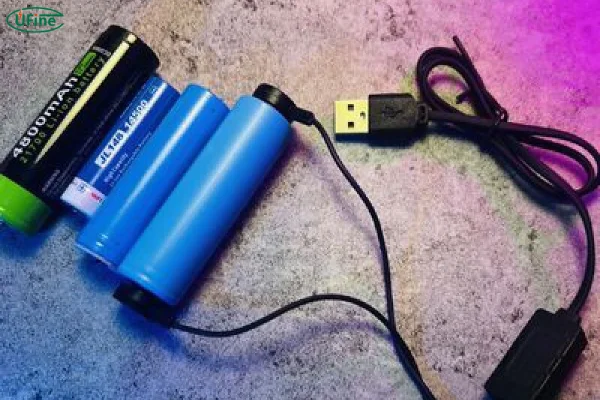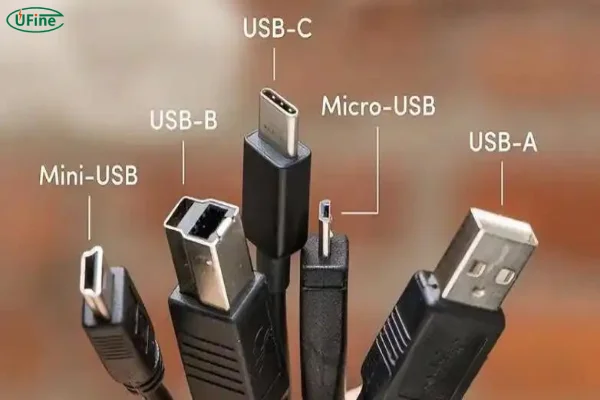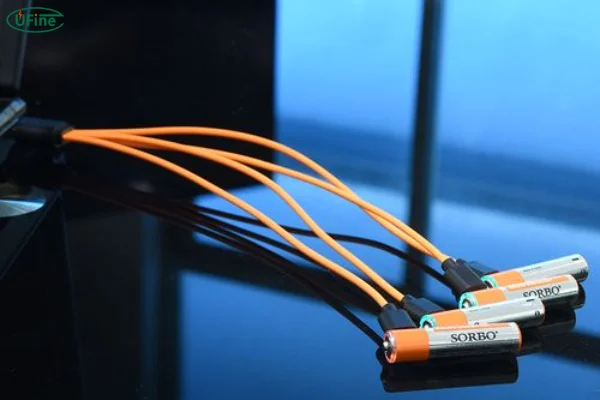
- Part 1. What are USB rechargeable batteries?
- Part 2. Types of USB rechargeable batteries
- Part 3. USB types for charging
- Part 4. Advantages and disadvantages
- Part 5. Applications
- Part 6. USB rechargeable batteries AA
- Part 7. USB rechargeable lithium-ion battery
- Part 8. Chargers for USB rechargeable batteries
- Part 9. Can USB rechargeable batteries be fast charged?
- Part 10. Buying the best USB rechargeable batteries: key considerations
- Part 11. Conclusion
Part 1. What are USB rechargeable batteries?

In the age of technology, convenience is key, and USB rechargeable batteries have emerged as a game-changer. So, what exactly are these batteries? Simply put, they’re batteries designed to be easily recharged using a USB cable, allowing users to avoid the need for traditional battery chargers or disposable batteries.
These batteries typically feature a built-in USB charging port, making them convenient and versatile. Instead of relying on bulky chargers or adapters, all you need is a USB port—whether that’s a laptop, a wall charger, or even a power bank. It’s as simple as plugging in your battery to recharge, and you’re good to go.
But these batteries are more than just convenient. They’re also a more eco-friendly alternative to single-use batteries, offering an excellent way to reduce waste. Over time, you can save money and contribute to a cleaner environment by using rechargeable USB batteries.
Part 2. Types of USB rechargeable batteries
Now, when we talk about USB rechargeable batteries, we can categorize them based on the type of battery chemistry used. The two most common types of USB rechargeable batteries are NiMH (Nickel-Metal Hydride) and Li-ion (Lithium-ion). Each has its own set of advantages, depending on your needs.
-
NiMH USB Rechargeable Batteries:
- These are known for their reliability and ability to handle high discharge rates. NiMH batteries tend to have a slightly lower capacity than Li-ion but are often preferred for devices that require high bursts of power, like cameras or remote controls.
- Advantages: They are generally cheaper and more environmentally friendly. Plus, they don’t suffer as much from the “memory effect” (where the battery loses its capacity if not fully discharged before recharging).
- Disadvantages: They have a shorter lifespan than Li-ion batteries and are more prone to self-discharge when not in use.
-
Li-ion USB Rechargeable Batteries:
- These batteries are known for their higher energy density, meaning they can store more power in a smaller, lighter form. Li-ion USB rechargeable batteries are commonly found in devices like smartphones, laptops, and electric vehicles.
- Advantages: They last longer, are lighter, and hold a charge for longer periods. They also have a higher energy output and can be recharged more times than their NiMH counterparts.
- Disadvantages: Li-ion batteries are typically more expensive and can be more prone to overheating if improperly handled.
Part 3. USB types for charging
USB rechargeable batteries can come with a variety of charging interfaces, and it’s essential to understand the differences between them for maximum convenience. The main types of USB ports you’ll encounter are:
- USB-A: This is the standard USB port that you likely use to charge your phone or connect to your computer. It’s the classic USB port found on most chargers.
- USB-C: This newer standard is becoming more popular because it’s reversible and can handle higher power output. USB-C is commonly used for newer devices and offers faster charging capabilities.
- Micro-USB: While not as fast as USB-C, micro-USB is still widely used for smaller devices, including USB rechargeable batteries.
Each of these ports offers different advantages in terms of charging speed and convenience, so it’s essential to know what your device supports.
Part 4. Advantages and disadvantages
Like anything, USB rechargeable batteries come with their own set of pros and cons. Let’s break them down:
Advantages:
- Convenience: The ability to charge through a USB port is extremely convenient. You can charge your battery from virtually anywhere, including your laptop, car, or portable charger.
- Cost-Efficiency: While the initial investment might be slightly higher, USB rechargeable batteries save money in the long run because they can be reused hundreds, even thousands, of times.
- Environmental Impact: With no need to dispose of single-use batteries, you’re helping reduce electronic waste.
- Compatibility: These batteries are available in a wide range of sizes, including AA, AAA, and more, meaning they’re compatible with many household devices.
Disadvantages:
- Initial Cost: USB rechargeable batteries can be more expensive upfront than disposable batteries.
- Charging Time: Some types of rechargeable batteries (especially older ones) can take longer to charge compared to simply swapping out a disposable battery.
- Battery Lifespan: Depending on the quality of the battery, some may have a shorter lifespan, meaning they won’t hold a charge as well over time.
Part 5. Applications
USB rechargeable batteries are incredibly versatile and can be used in a variety of devices, from household gadgets to more specialized equipment. Some common applications include:
- Consumer Electronics: USB rechargeable batteries are often found in devices like portable speakers, wireless keyboards, and flashlights.
- Toys and Games: Many modern toys, especially electric or motorized ones, use USB rechargeable batteries, making them easy to maintain and reuse.
- Outdoor Equipment: Whether you’re using a headlamp for camping or a GPS device, these batteries are commonly found in outdoor tools that need reliable power.
- Medical Devices: Some medical devices, like hearing aids, also use rechargeable USB batteries for convenience and longer service life.
The versatility of USB rechargeable batteries makes them an essential part of many everyday items.
Part 6. USB rechargeable batteries AA
AA-sized USB rechargeable batteries are some of the most common. They work in any device that typically uses AA batteries, such as remote controls, cameras, and toys.
These AA USB rechargeable batteries come in both NiMH and Li-ion options, but Li-ion is becoming more popular due to its longer lifespan and higher capacity. The main benefit is that you can simply plug them into a USB port to recharge, rather than needing a separate charger.
Part 7. USB rechargeable lithium-ion battery
Lithium-ion USB rechargeable batteries are, without a doubt, the most common type used in modern electronics. Their high energy density means they last longer, and they’re much more efficient. These batteries are found in everything from smartphones to laptops, and their popularity is only growing.
The key feature of lithium-ion USB rechargeable batteries is that they can hold more power in a smaller space, making them ideal for compact, portable electronics. Their rechargeability ensures that devices can run for longer, reducing the frequency with which you need to replace batteries.
Part 8. Chargers for USB rechargeable batteries
Charging a USB rechargeable battery is simple, but choosing the right charger is important. There are several options available:
- USB Wall Chargers: These are the most common chargers and are often included with devices. You plug your battery into the USB port, and it recharges quickly.
- Multi-Battery Chargers: For households with several USB rechargeable batteries, a multi-battery charger allows you to charge multiple batteries simultaneously, saving you time.
- Solar Chargers: These eco-friendly chargers can be used to recharge USB batteries outdoors, offering a sustainable solution for outdoor enthusiasts.
Part 9. Can USB rechargeable batteries be fast charged?
Many USB rechargeable batteries, especially lithium-ion versions, can indeed be fast-charged. However, not all USB rechargeable batteries support this feature. To fast-charge a battery, you’ll need to ensure that both the battery and the charger are designed for fast-charging capabilities. Typically, this means using a USB-C charger with a high-power output.
Fast charging is incredibly useful for people who are on the go and don’t have time to wait for hours for a battery to recharge.
Part 10. Buying the best USB rechargeable batteries: key considerations
When buying a USB rechargeable battery, there are several important factors to consider:
- Battery Chemistry: Decide between NiMH or Li-ion based on your needs.
- Capacity: Look at the battery’s capacity (mAh rating) to ensure it meets your device’s power requirements.
- Size: Make sure the battery fits your device. Common sizes include AA, AAA, and 18650.
- Voltage: Check the voltage to match your device’s specifications.
- Recharge Cycle: Choose a battery with a high recharge cycle to ensure longevity.
- Charging Time: If fast charging is important, check the battery’s compatibility with fast chargers.
- Brand Reputation: Opt for well-known brands with good customer reviews to ensure reliability and safety.
Part 11. Conclusion
USB rechargeable batteries are an incredibly convenient, eco-friendly, and cost-effective solution for powering our devices. By understanding their types, advantages, and how to maintain them, you can make the most out of these rechargeable powerhouses. Whether you’re looking for AA rechargeable batteries for your household devices or a high-performance lithium-ion battery for more specialized equipment, USB rechargeable batteries are a fantastic choice.
Related Tags:
More Articles

What is the Difference Between Silver Zinc Battery vs. Lithium-ion Rechargeable?
Compare silver zinc and lithium-ion rechargeable batteries: energy density, cycle life, safety, cost, and uses in drones, medical devices, EVs, and electronics.
What are Watts and Watt Hours in Battery?
Understand watt vs watt-hour in batteries: key differences, how to calculate capacity, and why they matter. Includes free comparison table.
Best 10 Blood Pressure Monitor Battery Review: Finding the Most Reliable
Are you looking for a reliable Blood Pressure Monitor battery? Here is a complete guide with the top 10 best blood pressure monitor batteries.
Bluetooth Headphone Battery Guide: All You Need to Know
Maximize headphone battery life with expert tips! Learn how to charge, check, troubleshoot, and choose the best bluetooth headphone battery in 2025.
LiFePO4 Battery VS. Lithium-ion Polymer Battery: Which One Is Best?
Comprehensive comparison of LiFePO4 vs Lithium Ion Polymer batteries: energy density, safety, lifespan, cost. Find out which battery suits your needs in 2025.





